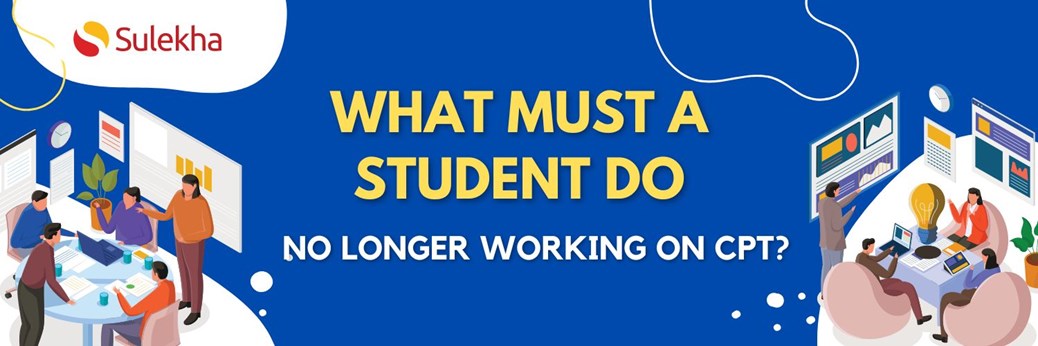What must a student do if they are no longer working on CPT?

What must a student do if they are no longer working on CPT?
For international students studying in the United States, Curricular Practical Training (CPT) offers valuable opportunities to gain real-world experience through internships and other work-based learning experiences. However, circumstances may change, and students may find themselves no longer working on CPT training for various reasons. This guide explores what international students should do if they're no longer working on CPT, providing helpful advice and resources to navigate this transition effectively.
Understanding Curricular Practical Training (CPT)
Before delving into what to do if you're no longer working on CPT, let's briefly review what CPT entails. The CPT program allows international students with F-1 visa status to gain practical work experience in their field of study while still enrolled in a degree program. This can include internships, co-op programs, or other employment forms integral to the curriculum and directly related to the student's academic program.
Immediate Actions:
Inform Your DSO: Your institution's Designated School Official (DSO) manages your immigration records. When your CPT ends, notify them in writing (email is acceptable). This helps them update your SEVIS record and ensures accurate information reflects your current status.
Update Your Employment Record: If you're still in active CPT status, even if you're not actively working, you must report your zero hours worked to your DSO through the designated system. This maintains your compliance with SEVIS regulations.
Consider Your Options:
- Return to Full-Time Studies: Focus on your academic program by enrolling in the required number of credits for full-time status (usually 12).
- Explore OPT: Optional Practical Training allows post-completion work authorization. Speak to your DSO to understand eligibility and application procedures.
- Seek New CPT: If your program allows further CPT experiences, discuss possibilities with your DSO and academic advisor.
- Prepare for Graduation: If nearing completion, connect with career services and start job hunting.
Working without authorization or violating CPT rules can jeopardize your F-1 status and future immigration endeavors. Always consult your DSO for clarity and guidance.
Maximizing Your CPT Experience:
- Understand Your Status: First and foremost, it's essential to understand your immigration status and any implications of no longer working on CPT. Consult with your designated school official (DSO) or an immigration advisor for guidance on how this change may affect your F-1 visa status and plans.
- Explore Alternative Opportunities: While your CPT employment may have ended, explore other opportunities for gaining practical experience or employment related to your field of study. This could include seeking new internships, volunteer opportunities, or part-time jobs aligning with your career goals.
- Consider OPT or STEM OPT: If eligible, consider applying for Optional Practical Training (OPT) or STEM OPT Extension. OPT allows F-1 students to work in their field of study for up to 12 months after completing their academic program. STEM OPT Extension provides an additional 24 months of work authorization for students in STEM fields.
- Reflect on Your Learnings: Analyze the skills and knowledge gained during your CPT. Update your resume and highlight accomplishments in interviews.Maintain Connections: Network with colleagues, supervisors, and mentors. These connections can provide valuable job recommendations or industry insights.
- Seek Feedback: Ask your supervisor for feedback on your performance. Use this to improve your skills and future work experiences.
Transitioning from CPT:
- Start Early: Don't wait until your CPT ends to plan your next steps. Research different pathways and connect with relevant resources early on.
- Utilize Career Services: your University’s career services can help with resume writing, interview skills, and job searching tailored to your field and visa status.
- Network Actively: Attend career fairs, industry events, and alumni gatherings. Expand your professional network and explore potential opportunities.
- Understand OPT Rules: If transitioning to OPT, thoroughly understand the application process, timelines, and limitations to avoid delays or complications.
Eligibility
- CPT is integral to your major, and the experience must be part of your program of study.
- When you enroll at the graduate level, your designated school official (DSO) may authorize CPT during your first semester if your program requires this experience. Ask your DSO for details.
- Your DSO will provide you with a new Form I-20, “Certificate of Eligibility for Nonimmigrant Student Status,” that shows that the DSO has approved you for this employment.
- You can work on CPT either full-time or part-time.
- CPT requires a signed cooperative agreement or a letter from your employer.If you have 12 months or more of full-time CPT, you are ineligible for OPT, but part-time CPT is fine and will not stop you from doing OPT.
Transitioning out of CPT employment can be a significant change for international students, but it's essential to approach it with a proactive mindset and a clear plan of action. By understanding your options, exploring alternative opportunities, and staying informed about immigration regulations, you can navigate this transition effectively and continue progressing on your academic and career journey.
Take the next step towards your professional goals
Want to hire the best talent?
Start Advertising
Post Job AdMake a call
+1-512-580-7444Latest Jobs in New York Metro Area
Account Assistant / Bookkeeper Assistant
- New York, NY
- Account Assistant
Cloud Data Pipeline Developer (AWS/GCP/Azure) RM
- New York, NY
- Business Analyst
Full Stack Python Developer, Richmond VA - ST
- New York, NY
- Software Developer
Job Description: Mobile Application Developer (iOS / Android / Hybrid) R
- New York, NY
- Software Developer
Latest blogs on technology to explore

From Survival to Success: How Sulekha Jobs Helps Immigrants Find Their First Break
Moving to the USA or Canada is a bold step—filled with dreams, determination, and a dash of uncertainty. For many immigrants, the first challenge isn’t just settling in—it’s finding that first job. Whether you're a recent graduate, a skilled professi

Verified Recruiters, Real Opportunities: Why Sulekha Jobs Is a Game-Changer
Let’s face it—job hunting can feel like a maze. You apply to dozens of listings, wait endlessly, and often never hear back. Worse, some platforms are flooded with outdated posts or sketchy recruiters. That’s where Sulekha Jobs flips the script.

Top 10 High-Paying Part-Time Jobs for Students in the USA & Canada
Being a student isn’t cheap. Between tuition fees, rent, and a never-ending coffee habit, most students in the USA and Canada turn to part-time work to ease the financial load. But here’s the good news: not all part-time jobs are created equal—some p

Jobs That Keep the World Moving (Literally): A Tribute to Logistics Workers
Let’s be honest — when we think of jobs that keep the world running, logistics workers don’t always get the spotlight. But they should. From warehouse staff and delivery drivers to supply chain managers and forklift operators, these are the unsung he

No Degree? No Problem! Jobs That Hire Based on Skills, Not Certificates
Here's the truth nobody talks about: some of the most successful people in America never stepped foot in a college classroom for a degree. While society has spent decades pushing the "college or bust" narrative, smart employers are waking up to reali

Dallas Needs Assistant Store Managers – Join Now for Fast Growth!
If you’ve got a knack for leadership, love working with people, and thrive in a fast-paced retail environment—Dallas is calling! Assistant Store Manager roles are popping up across the city, and it’s the perfect time to jump in and grow your career.

Beyond the Resume: What Employers Really Want in 2025.
In 2025, the job market in the US and Canada is buzzing with opportunities—but also fierce competition. While a polished resume still matters, it's no longer the golden ticket to landing your dream job. Employers today are looking beyond the resume,

IT or Not IT? High-Demand Jobs in 2025 That Pay Well (Even Without Tech Skills)
Let’s be real — when you hear “high-paying job in 2025,” your mind probably jumps to coding, AI, cloud computing, or some other tech-heavy gig. And sure, IT jobs are booming (no shade!). But here’s the good news: you don’t need to know Python to make